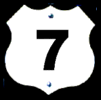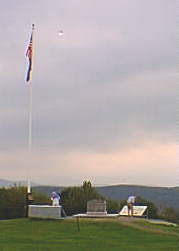BENNINGTON BATTLEFIELDNEW YORK |
 |
BENNINGTON BATTLEFIELDNEW YORK |
 |
 |
Battle of Bennington First Engagement August 16, 1777 General John Stark with New Hampshire, Vermont, and Massachusetts militia defeated and captured an expeditionary force sent by General Burgoyne and commanded by Colonel Baum. This was one of the first decisive victories in the War of the Revolution. |
At the entrance to the battlefield, there is a marker. Inside the gates, there is a very narrow road through a heavily wooded area that climbs to the summit of a hill. At the top of the hill, there are three stone memorials, other markers, a relief map showing the battlefield area and a parking area.
 |
By the end of July 1777, the British invasion from Canada under General John Burgoyne had progressed to Fort Edward on the Hudson River. Desperately in need of supplies, Burgoyne, on August 11th dispatched an expedition under Lieutenant Colonel Friedrick Baum to capture the American storehouse at Bennington, VT, which were thought to be guarded by only a handful of rebel militia. About half of Baum's troops were mercenaries who only spoke German. Although from Brunswick, these men, like all German troops, were commonly called Hessians by the Americans. The rest of Baum's forces consisted of smaller detachments of British sharpshooters, Indians, Canadians and American Loyalists. The British, however, grossly underestimated American strength. New Hampshire had raised over 1,500 under General John Stark to meet Burgoyne's threat. An additional militia from Vermont and Western Massachusetts also turned out. Aware that the American resistance was growing, Baum, on August 14th, encamped his troops on and around this hill, just five miles from Bennington to await reinforcements. On August 16th, following a day of rain, Stark deployed his troops to attack Baum from all sides. In a two-hour battle, Baum's outposts collapsed and the main redoubt atop this hill was overrun, but not before Baum's dragoons gamely fought off the attackers with their sabers. Too late to help Baum, reinforcements under Lieutenant Heindrick von Breymann approached from the west, only to driven off by Seth Warner's Vermont Militia. Baum was killed in the battle as were 200 hundred of his men and all but a few of the remainder became American prisoners. "Wherever the King's Forces point, militia to the amount of 3,000 or 4,000 assemble in 24 hours" a frustrated Burgoyne wrote to his superiors after the defeat. "Vermont has to contain the most rebellious race on the continent and hangs like a gathering storm upon my left." Americans made their stand at Saratoga where Burgoyne, his army weakened by dwindling supplies, surrendered on October 17, 1777. |
 |
|
 |
Bennington Battlefield — Some of the markers indicate battlefield positions including those of Colonel Nichol's New Hampshire Regiment and Colonel Herrick's Vermont Rangers. There is one stone memorial for each of the participating states.
 |
Battle of Bennington Second Engagement August 16, 1777 At this point occurred the defeat of Colonel Breymann who commanded a force of 600 men sent by General Burgoyne to reinforce Colonel Baum. Colonel Seth Warner and his regiment of Vermont Rangers and Green Mountain Boys distinguished themselves in this action. |
Bennington Battlefield, Second Engagement — About a mile past the entrance to the battlefield is the town of Walloomsac, NY. Across the street from the Walloomsac home (1843) and to the right side of a local restaurant, there is a marker for the second engagement.
Friedrich Baum Marker.
|
|
A few feet east of this marker stood the house, removed about 1870, in which Lieutenant Colonel Friedrich Baum died. Commander of the enemy forces, he was mortally wounded in the battle of Bennington and died two days later, August 18, 1777. He was buried on the north bank of the Walloomsac River west of this site. The precise spot not now being known. |
